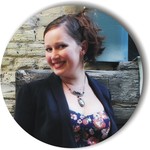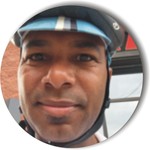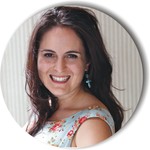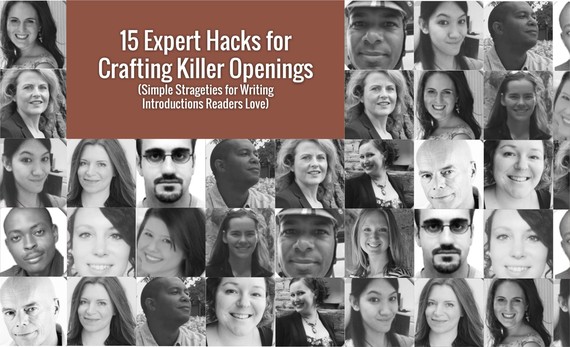According to a Writers Digest piece, the opening line makes or breaks a story. If it doesn't grab readers' attention immediately, it's over.
As content creators, your openings are the most important part of your content creation right after your headline.
If it doesn't lead your readers to the next paragraph, you'll lose them. Often, for life.
So, how do you craft blockbuster introductions that keep readers scrolling?
Below, fifteen online/offline writing experts share their best hacks for capturing and retaining their readers' attention with scroll-worthy introductions:
1. Bamidele Onibalusi
Freelance Writer & Founder, Writers In Charge

I recent had to "clean up" my browser; I have about fifty tabs opened and this has been making my computer really slow, and some of these tabs have been there for over a month. This got me thinking about how I prioritize content I read, and I came to the realization that I almost always pay more attention to articles that start with a story. This is also my best tip for writing irresistible openings; most of my most successful articles begin with a story.
Research also shows that, when asked to recall speeches, 63 percent of people are more likely to remember the stories in a speech while just 5 percent will remember any individual statistic.
2. Kristi Hines
Freelance Writer & Ghostwriter

I like to write my opening paragraph last. That way, I know what I've covered in the post and I know what people are going to get out of it. Hence, I can lead with that. :)
3. Alicia Dara
Founder, ADMC Creative

A good lede invites us to feel a story through our senses. It includes descriptions of environment, such as weather, scents, and sounds. It describes surfaces that could be touched, or walked on: are they jagged and rusty, or glassy and calm? How does a person breathe in this story: through clenched teeth, or an open smile? What color is the subject's voice? Is it bold or faded? Humans are visceral, physical, humming with energy. We long to be met in this place of shared knowing.
We've all grown used to screen-sitting; hunched over, jaws clenched, hands into claws pecking away at the tiny letters underneath. This is the 21st-century posture of a person engaged with their own mind while reading, writing, thinking and dreaming. But the sensual world is always here, always beckoning, begging to be let in. A good lede can open that door.
4. Lizzie Wanderful
Professional Business and Lifestyle Writer

The key to crafting a compelling opening is to draw the reader in. You want to a) give them a taster of what's to come, and b) encourage them to read on. I've found the best way to do this is to start with a story that relates to the topic but that adds a human element to it. As humans we LOVE stories. We seek them out everywhere we go, and they help us make sense of ourselves and our lives.
Initially, the story might not have anything to do with the topic, but eventually it should "click" as to why you've led with it. The reader will not only want to read on to discover how the story ends, but they might also be curious about how your story relates to the topic."
5. Sarah Greesonbach
Founder, Five Figure Writer

In today's click-happy culture, the headline gets the reader and the lede gets the reader's attention. It's such an important part of the article that it can even set the tone for the feedback you get from your client -- they'll read it and either think, "Oh no!" or "Oh yeah!"
To write the most irresistible and compelling lede possible, I actually recommend writers start by being as boring as possible. In an outline form, state the background facts and your lede in as clear and straightforward language as possible, and then write the body of the article.
When you finish the body and conclusion, come back to the lede. Work it into an introduction that makes the body of the article come alive by being timely to the news cycle, funny or snarky in a way the audience enjoys, or relevant to the target audience's most pressing problem.
6. Aoife O'Carroll
Freelance Writer & Web Content Provider

The importance of creating compelling headlines for your articles is drummed into every writer, but what happens then? There's little point in engaging eyeballs with a powerful title, if the rest of the material fails to deliver. You need to nail the introduction, too.
If you want people to continue reading your article, don't waste your great headline with an irrelevant, unoriginal, or plain dull intro. Do this instead:
- Draw them in with an arresting phrase or a word (questions are good).
- Create a connection between the phrase/word and the body of the article by clarifying your title.
- Summarize the body of the article.
Now you have an intro that gives readers both an explanation for your wonderful headline and a reason to continue reading your amazing article.
7. Francesca Nicasio
Freelance Writer & Founder, Be A Freelance Writer

A killer lede starts with an in-depth understanding of your target audience. Figure out who they are and what want or need, then write your opening in such a way that it promises your readers that they'll get a lot of value out of your content.
For example, I recently published a post on how freelancers can find and keep long-term clients. To grab my readers' attention right from the get-go, I talked about the benefits having long-term clients, and I promised that by the end of the post, they'll learn exactly how they can land these customers.
Consider doing something similar for your next piece. Figure out the main value that readers will get out of reading your post, and succinctly communicate that in your opening."
8. Jessie Lawlor
Personal Branding Expert & Speaker

Creating a compelling opening is often one of the most difficult parts of writing a blog post or article.
I take two different approaches:
- I write the opening first. If I already have a strong idea of what I'm going to write about (perhaps I have a headline in mind), I'll often aim to writing my opening paragraph right away. This helps to get my creative juices flowing and sets the tone for the rest of the piece.
9. Sagan Morrow
Professional Lifestyle Blogger

As much as possible, use that first sentence or two as an opportunity to let your readers know what to expect in the article, in language that appeals to them. They should be able to identify immediately what the main topic of the article is -- but that alone won't necessarily be enough to capture their attention. Your writing style and tone and the word choices you make are just as important for captivating readers so they continue to read your entire article. Use the same type of language and voice that resonates most with your ideal reader.
When it comes to writing blog posts specifically, start the article by having a conversation with your readers. Talk to them as you would your friends! When you craft your article in a way you might begin a conversation with a good friend, you'll engage with your readers on a more personal level.
10. Gerald Rhodes
Owner, GeraldRhodes

Finding a compelling lead in to a story, article or post can be difficult. Many people begin the lead from what they want to say.
I found the best way to create a great lead is to think about the needs of my audience. As soon as I come from the point of view of the reader, immediately answer a question they want to know the answer to, I can get them to read further. It is always about playing to my audience's needs and interests. It's not about writing about my interests. That is what a journal is for. I write to provide greater value for my audience.
I also believe in writing the article from my reader's point of view. I search google for the most popular topics in my niche. Then I craft a post that answers a question in this topic. This is one great technique that I have found that establishes me as a trusted authority for the information that is important to my audience.
11. Todd Worley
Owner, ToddWorley

My best strategy for crafting irresistible openings is to put myself in my audience's shoes and think of the most important question that my article answers that will entice my audience.
Then I use that question right in my opening statement to get people pondering, "What could the answer be?" Ultimately they have to read the article to find out.
This is a great strategy because it creates a little doubt in people's minds that if they don't read the article they are going to be missing out!
12. Marian Schembari
Founder, Oh Hai! Copy

It doesn't matter if you're writing web copy or a novel. You have to start halfway through the story, right when the action starts. Most writing teachers will tell you that backstory is irrelevant to the reader. What they don't tell you is that it's extremely relevant to the writer. Because like athletes or musicians, writers need to warm up.
My strategy is to write that long-winded introduction anyway, knowing full well I'll end up deleting it. This helps stretch my writing muscles and make room for that killer opening line to spill out on the page. Once I've word-vomited for 30 minutes or so, I highlight everything up to the most action-packed first line, cut it, then save it to a separate document (hey, it might be useful later).
What remains is immediate action -- drawing readers in from the first word.
13. Kristen Pope
Freelance Writer and Editor

Place the reader right in the heart of the action. For example, if you're writing about someone's hiking adventure gone awry, don't spend the first five paragraphs examining the types of sedimentary rock nearby and then a few more paragraphs describing a bird's nest before you get to the action. Weave those details in at some point and "paint a picture," but don't linger on them too much in your lede.
Consider starting the story with the moment things started to go wrong, when the hiker took a wayward turn, slipped on a rock, or spooked an animal. Or open with the foreboding feeling they had while eating their oatmeal that morning.
Put the reader in the scene, and focus on the moment the character's day transitioned from run-of-the-mill to potentially disastrous. Don't manufacture drama, but do focus on the most compelling start of the story first to capture readers' interest.
14. Thomas B. Rosenstand
Founder, Concept Interest

To write great openings you need to have your story/article done. If you write like I do you just let it flow without a plan - your fingers typing creates the structure. A good writer often writes sentences or phrases that will take him/her by surprise afterwards. And very often the opening is right there: In the midst of the somewhat autonomously created content.
Read what you wrote. Find the odd statement or question. Feed it a little in your mind and the opener will come.
Can you start by having the ultimate opening in your head and then build a story
around it? Some can -- but most will fail and utterly so. The limitations of writing around an opener are too much. It will fight you, limit you and end you.
Now I wrote this -- then I read it and then I found my opening to this very brief
statement.
Can you see the opening? It is right here: "It will fight you, limit you and end you." Most readers will be curious to find out exactly what this means. Right?
15. Mike Martyns
Founder, SoccerGearhq

I usually follow the A.P.P. method for my introductions. If you follow this approach, you'll grab your readers' attention right there and gain their interest in reading the rest of your work too.
Here's how it goes. The "A" stands for "Agree" and that's how you should start your introduction, by "agreeing" with your reader. You have to show them you know their problem or that you acknowledge their questions or doubts. Now that they can relate to you, give them the "P". It stands for "Promise" or "Proposal". This is where you reveal that their problem or question does have a solution or answer. You've just caught their attention.
Finally, make use of the last "P". It stands for "Preview"; this is where you will tell them exactly what they can find in your article. Congratulations, you have also gained their interest in reading everything you wrote.

